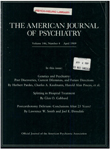Distribution of treated mental illness in the neighborhoods of Jerusalem
Abstract
The authors compared the rates of treated mental illness among ethnically advantaged Ashkenazic Jews and ethnically disadvantaged Sephardic Jews in four areas of Jerusalem defined by socioeconomic status. They found that the rates of illness were higher in areas of lower socioeconomic status, that the Ashkenazim had higher rates of illness than the Sephardim in the areas of lower status, and that there was a comparatively high rate of illness among the Ashkenazim in the very religious Jewish neighborhoods. They interpret these findings on the basis of the theories of social causation and social selection, including genetic transmission.
Access content
To read the fulltext, please use one of the options below to sign in or purchase access.- Personal login
- Institutional Login
- Sign in via OpenAthens
- Register for access
-
Please login/register if you wish to pair your device and check access availability.
Not a subscriber?
PsychiatryOnline subscription options offer access to the DSM-5 library, books, journals, CME, and patient resources. This all-in-one virtual library provides psychiatrists and mental health professionals with key resources for diagnosis, treatment, research, and professional development.
Need more help? PsychiatryOnline Customer Service may be reached by emailing [email protected] or by calling 800-368-5777 (in the U.S.) or 703-907-7322 (outside the U.S.).



